| dc.contributor.advisor | Judy Layzer. | en_US |
| dc.contributor.author | Buckingham, Katherine (Katherine Eleanor) | en_US |
| dc.contributor.other | Massachusetts Institute of Technology. Department of Urban Studies and Planning. | en_US |
| dc.coverage.spatial | n-us-ma | en_US |
| dc.date.accessioned | 2013-10-24T17:36:33Z | |
| dc.date.available | 2013-10-24T17:36:33Z | |
| dc.date.copyright | 2013 | en_US |
| dc.date.issued | 2013 | en_US |
| dc.identifier.uri | http://hdl.handle.net/1721.1/81626 | |
| dc.description | Thesis (M.C.P.)--Massachusetts Institute of Technology, Dept. of Urban Studies and Planning, 2013. | en_US |
| dc.description | Cataloged from PDF version of thesis. | en_US |
| dc.description | Includes bibliographical references (p. 47-50). | en_US |
| dc.description.abstract | Communities across the country struggle with the challenge of redeveloping vacant or underused, contaminated land, commonly referred to as "brownfields." Brownfields blight their neighborhoods and cause damage relating to poor environmental quality, detriments to public health, and decreased confidence in the surrounding area. Even though redeveloping brownfields offers numerous benefits, the process is an uphill battle for developers and municipalities alike. Given the multiple barriers to brownfield redevelopment, including: the difficulty of determining the level of contamination, unknown cleanup costs, uncertainty surrounding the extent of liability, the challenge of obtaining grants or outside funding to cover cleanup costs, and the unreliable development timeline, it is not surprising that private developers are often reluctant to undertake brownfield redevelopment projects on their own. Therefore, government plays a crucial role in spurring the redevelopment of brownfields to return them to productive reuse. Massachusetts' Brownfields Support Team (BST) Initiative offers an example of an innovative state program that takes a proactive approach to expediting brownfield redevelopment through the creation of interagency teams that meet monthly to facilitate assessment, cleanup and redevelopment of especially complicated sites. This thesis investigates the effectiveness of the BST through the experiences of two case studies: The Uniroyal and Facemate properties in Chicopee and the Kiley Barrel site in Somerville's Union Square. Through an analysis of these cases, this thesis aims to illustrate how and why the program is effective. Ultimately my research reveals that the BST approach was able to build strong relationships, generate creative solutions, and expedite the brownfield redevelopment process in both cases. This thesis also aims to inform other states' policies surrounding brownfield redevelopment with a discussion of the replication this program in other contexts. | en_US |
| dc.description.statementofresponsibility | by Katherine Buckingham. | en_US |
| dc.format.extent | 50 p. | en_US |
| dc.language.iso | eng | en_US |
| dc.publisher | Massachusetts Institute of Technology | en_US |
| dc.rights | M.I.T. theses are protected by
copyright. They may be viewed from this source for any purpose, but
reproduction or distribution in any format is prohibited without written
permission. See provided URL for inquiries about permission. | en_US |
| dc.rights.uri | http://dspace.mit.edu/handle/1721.1/7582 | en_US |
| dc.subject | Urban Studies and Planning. | en_US |
| dc.title | Massachusetts' Brownfield Support Team Initiative : program design and implementation in Somerville and Chicopee, Massachusetts | en_US |
| dc.type | Thesis | en_US |
| dc.description.degree | M.C.P. | en_US |
| dc.contributor.department | Massachusetts Institute of Technology. Department of Urban Studies and Planning | |
| dc.identifier.oclc | 859156019 | en_US |
